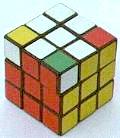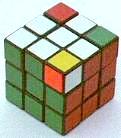THE CORNER PIECE SERIES
The corner pieces are put into proper position/orientation following the placement of the 12 edge pieces. After the edge pieces are placed we will find some corner pieces may already be correctly placed while some are properly positioned but not properly oriented. The remainder will be in the wrong position. The incorrectly placed corner pieces will be moved into proper position/orientation using the Corner Piece Series.
The Corner Piece Series has eight 90o turns and is perfectly symmetrical. The first turn is always a turn of the top face. Such a turn is indicated by a curved arrow on the top face of the cube with the point of the arrow ending on the back part of this face. The first figure in the set of eight below indicates that the top face is rotated clockwise. We will say that this face is turned to the right because the arrow at the back of the top face points to the right. This is simply a convention but it will enable you to more easily recall this series. The symbols below indicate the eight turns in one example of the series. You are looking down on the top face of the cube.
![]()
The first move of the top face may be either to the right or to the left , but the rules governing the succeeding moves are the same in either case. The second symbol shows that the top surface of the right face moves away from you.
1. The first move is a turn of the top face, either to the right or to the left.
2. The second move is a turn of the side face toward which the top was turned. It is turned away from you.
3. The top is then turned in the direction opposite to the first turn.
4. The side toward which the top was just turned is then turned away from you.
5. The top is then turned in the same direction as the first turn.
6. The side toward which the top was just turned is then turned back toward you.
7. The top is turned in the opposite direction.
8. The side toward which the top was just turned is turned back toward you.
The top is turned every other turn, alternating directions. Each side face is first turned away and then back toward you. Note that each of the initial turns is later reversed.
This series will cause three corner pieces on the top face of the cube to move about a triangle. If the first turn of the top face is to the right then the corner pieces will move in a counterclockwise direction about the triangle. If the first turn is to the left then three pieces (two are the same but one is different) will move in a clockwise direction about a triangle which is a mirror image of the first triangle.
Let us apply a Corner Piece Series (with the first move being a turn of the top face to the right) to the cube in Fig. 3a. In this case the orange face is the front of the cube. The result is the cube in Fig. 3b. We can see that the left/front/top, the left/back/top and the right/back/top pieces have been moved. We get a another view of the changes by rotating the cube 180o giving us Fig. 3c.



Fig. 3a
Fig. 3b
Fig. 3c
The red/green/white corner piece moved along the red/white edge and into the red/yellow/white corner. In the process it "rolled over" so that the white face is now on the side of the cube and in the yellow face. The red/yellow/white corner piece moved along the yellow/white edge and also "rolled over". The yellow/orange/white piece moved across the diagonal of the top face. In the process it's yellow face, which had been on the left (yellow) side, came to the top.
Note that the two corner pieces on the back of the top face and the corner piece at left/top/front are involved in this triangle. The pieces moved counterclockwise. All three "rolled over".
If the first turn of the top face had been to the left the two pieces at the rear would still be involved but the third piece would be the one in the front/right/top corner. This piece would move across the diagonal to the left/back/top corner. The pieces would move in a clockwise direction about the triangle.
Obviously the two pieces at the back of the top face are always involved along with one of the pieces at the front. How can you tell which one? You should note that the first turn immediately moves the front corner piece involved to the back of the top face. It is this piece which will eventually move across the diagonal of the top face.
If the three out-of-position corner pieces were to move in the opposite direction about the same triangle they would move back into position/orientation. These three pieces illustrate what you will be looking for as you try to solve a scrambled cube.
The red/white/green piece may be made to move along the red/white edge of the cube. As it does so it will roll over into its proper position/orientation. The yellow/white/red corner piece will do the same thing as it moves along the yellow/white edge of the cube.

Fig. 3d
The cube has been turned another 90o in Fig. 3d. Now you see an example of a corner piece which can be moved across the face diagonal to its proper position and orientation. For this corner piece, the color of the top face (white) is on the right side. The orange and yellow colors do not match any side which is visible. But you should know that orange is opposite red and that yellow is opposite green. Hence this corner piece has the colors of the opposite corner.
The Corner Piece Series which begins with a turn of the top face to the left will move the orange/white/yellow corner piece across the diagonal with the white face coming to the top. The other two pieces move along cube edges and roll over into their proper position and orientation. The cube is again complete.
Of course you will not often find three corner pieces arranged so that all move into correct position/orientation in a single series. Most of the time you will find one which can move into place along a cube edge. Less often it will be a corner piece which can move across a face diagonal and into its proper position and orientation. At times there will be two pieces which can be moved into place in a single series and rarely three. But if you should find three in such an arrangement you certainly would want to take advantage of that fact.
Go to Step One: THE CROSS